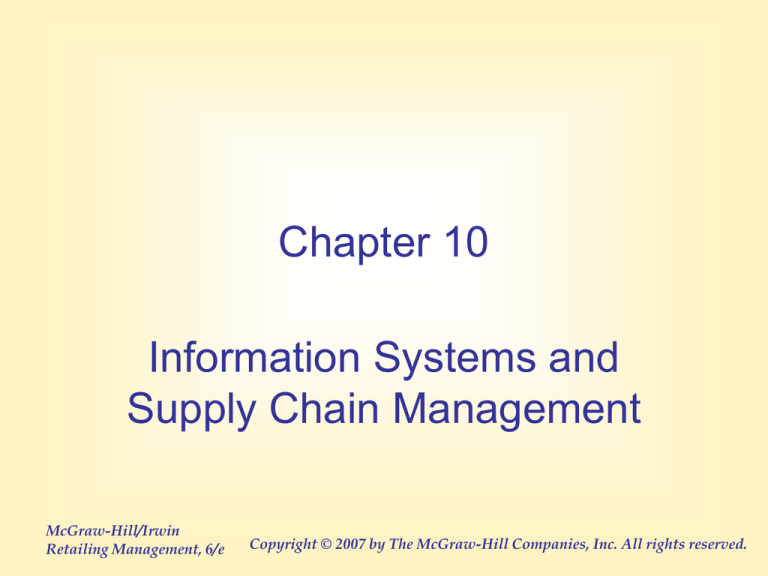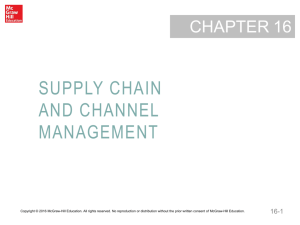
Chapter 10
Information Systems and
Supply Chain Management
McGraw-Hill/Irwin
Retailing Management, 6/e
Copyright © 2007 by The McGraw-Hill Companies, Inc. All rights reserved.
10-2
Retailing Strategy
Retail Market Strategy
Financial Strategy
Site Location
Information Systems
Retail Locations
Organizational Structure and
HR Management
Customer Relationship
Management
10-3
Supply Chain Management
Supply chain management is the delivery of
economic value to customers through
management of the flow of physical goods and
associated info from vendors to customers
Ryan McVay/Getty Images
Strategic Importance of
Supply Chain Management
• Opportunity to Reduce Costs
– Transportation Costs
– Inventory Holding Costs
• Provide Value to Customers by Making
the Right Merchandise is in the Right
Place at the Right Time
– Fewer Stockouts
– Greater Assortment with Less Inventory
• Improved ROI
10-4
10-5
Improve Return on Investment
Return on assets = Net profit margin x Asset turnover
Net profit =
Total assets
Net profit x Net sales
Net sales
Total assets
Efficient Supply Chain Management Higher Asset Turnover
Same Sales Using Less Inventory
10-6
Illustration of Supply Chain
10-7
Benefits of Efficient Supply Chain
Management
Fewer stockouts – merchandise will be
available when the customer wants them
Tailoring assortments – the right
merchandise is available at the right store
Customers respond to the convenience as
evidenced by increased sales
Ryan McVay/Getty Images
10-8
High Return on Investment
An efficient supply chain can improve a retailer’s ROI
• Increases sales – customers are offered more
attractive assortments
• Net profit is improved by increasing gross margin and
lowering expenses
• Inventory levels are lower, lower investment and total
assets are lower with asset turnover higher
PhotoLink/Getty Images
10-9
Wal-Mart’s Sustainable Advantage
Wal-Mart’s success is its information and supply chain
management systems. Why are competitor’s lagging behind?
Wal-Mart made a substantial investment
in developing its systems and has the
scale economies to justify it.
The software is unavailable
elsewhere and is constantly
updated and improved
Ryan McVay/Getty Images
10-10
Minimizing Stockouts
Stores need to place
orders with distribution
centers in a timely
fashion
Make sure merchandise
in stockrooms is on the
shelves
Distribution
Centers need to
send right
quantities
Buyers place
orders at the
right time with
vendors
Royalty-Free/CORBIS
Managers need to provide
enough lead time for deliveries
Forecast demand accurately
10-11
Information and Merchandise Flow
10-12
Information Flow
10-13
Flow of Merchandise
Efficient supply chain would
know the customer
Store would advertise to these
customers
Buyers would purchase more
of this wine
Distribution center would be
prepared to distribute the wine
PhotoLink/Getty Images
10-14
Information Flow
1. When customer makes a
purchase, sales associate
scans UPC code or RFID chip on
merchandise and customer
credit card/loyalty card
Steve Cole/Getty Images
2. Information about purchase is
transmitted from POS terminal to the
buyer/planner
3. Information about purchases are
aggregated by buyer/planner and
sent to distribution center and
vendor to ship merchandise
StockTrek/Getty Images
10-15
Information Flow
4. Buyer/planner communicates with
vendor and places a purchase order
to re-supply stores.
5. Buyer/planner notifies distribution
center about incoming orders and
how they are to be distributed to stores
PhotoLink/Getty Images
6. Store managers inform
distribution center about
receipt of merchandise
and coordinate deliveries
David Buffington/Getty Images
10-16
Data Warehousing
Data warehousing is the coordinated and periodic
copying of data from various sources, both inside
and outside the enterprise, into an environment
ready for analytical and informational processing
Wal-Mart makes good use of its data warehouse.
It should. Experts estimate that it is second in
size only to that of the U.S. government
10-17
Electronic Data Interchange
• EDI is the computer-to-computer exchange of
business documents between retailers and vendors
• Merchandise sales
• Inventory On Hand
• Orders
• Advanced shipping notices
• Receipt of merchandise
• Invoices for payment
Royalty-Free/CORBIS
10-18
EDI Security
There are implications of security failures (loss of data, loss of
public confidence), but retailers have security policy objectives:
Authentication – system assures person on
other end of session is who it claims to be
Authorization - that person has permission to
carry out request
Integrity – info arriving is the same that was
sent
Ryan McVay/Getty Images
10-19
Benefits of EDI
• Reduces cycle time – inventory turnover is
higher
• Improves overall quality of communications
through better record-keeping
• Information can be easily analyzed
Stockbyte/Punchstock Images
10-20
Advantages of Using a Distribution Center
• Effects of forecast error for individual stores are
minimized
• Enables retailers to carry less merchandise in
the store
• Easier to avoid running out of stock
• Retail store space is more expensive than space
at the distribution center
Ryan McVay/Getty Images
10-21
Logistics Strategy
Pull Supply Chain
Merchandise shipped
to stores based on
sales and inventory
levels in the stores
Push Supply Chain
Merchandise shipped to
the stores based on
forecasted sales rate
(c) Brand X Pictures/PunchStock
10-22
Merchandise Flow
10-23
Activities Performed by Distribution Center
•
•
•
•
Managing inbound transportation
Receiving and checking merchandise
Storing or cross docking merchandise
Preparing merchandise for the sales
floor
– Ticketing and marking
– Putting on hangers
• Shipping merchandise to
stores
• Managing outbound
transportation
Ryan McVay/Getty Images
10-24
Who Can Use DC’s?
• Retailers selling non-perishable
merchandise
• Retailers offering merchandise
that has highly uncertain
demand like apparel
• Retailers selling merchandise
that needs to be replenished
frequently
• Retailers that carry a large
number of items shipped in
broken case quantities like drug
stores
• Retailers with many outlets
Ryan McVay/Getty Images
10-25
Crossdocking
Ryan McVay/Getty Images
Merchandise flows directly from the vendor’s trucks
through the retailer’s distribution center and is
loaded on the trucks going to the retailer’s stores
without being stored in the distribution center
10-26
Reverse Logistics
Retailers recover loss through on-line auctions
© image100 Ltd
Customer
The McGraw-Hill Companies,
Inc./Andrew Resek, photographer
Store
Steve Cole/Getty Images
Distribution Center
Royalty-Free/CORBIS
Vendor
10-27
Bull-Whip Effect
An uncoordinated channel of built up
inventory when retailers and vendors do
not coordinate their supply chain activities
10-28
What Causes a Bull-Whip Effect?
Chad Baker / Ryan McVay/Getty Images
• Delays in transmitting orders and receiving
merchandise
• Over-reacting to shortage
• Ordering in batches rather than generating
a number of small orders
10-29
Retailers and Vendors Work Together
By working together they can
reduce the level of inventory in
the chain and reduce the
number of stockouts.
• Use EDI
• Exchange information to reduce need for
backup inventory, improve sales forecasts and
production efficiency
• Vendor manage inventory
• Collaborative planning, forecasting and
replacement
PhotoDisc/Getty Images
10-30
Initial Efforts at Coordinating
Vendor and Retailer Supply Chain
• Efficient Consumer Response (ECR) –
Food Retailing
• Quick Response (QR) - Apparel
10-31
Packaged Goods Manufacturers
• Promotions > Advertising
– consumer promotions - coupons
– trade deals
• Why?
– Short-Term Orientation
– Competitive Reaction
– Power of Supermarkets
10-32
Efficient Consumer Response
• Trade Promotions ==> Forward Buying
==> Extremely Uneven Production
• Motivation for Packaged Goods Mfrg
– Stop Price Promotion, Forward Buying
– Level Out Demand
• Motivation for Supermarkets
– Rise of Warehouse Clubs/Discount Store
• Use of EDLP Pricing
– Need to Become More Efficient
– Excessive Inventory - $30 Billion
10-33
Response by Manufacturers
• P&G - Reduce Consumer Promotion
• Increase Advertising
– Build Brand Image, Loyalty
– Reduce Price Sensitivity
• Every Day Whole Price - No Trade
Promotions
Mfg-Distributor/Retailer Fashion, Clothing –
Quick Response Consumer
10-34
• Inherently Unpredictable Demand
• Old Solution - Over Buyer and Markdown
• Quick Response
– Provide Initial Assortment
– Forecast Sales for Intermediate Form
– Monitor Early Sales
– Make Final Assortment
10-35
Vendors and Retailers Working Together
• Inherent Conflict
• Motivating Collaborative Solutions
– Mutual Idiosyncratic Investment –
Credible Commitments – Schilling (NATO
Troop)
– Need Safe Guards
– Trust vs. Contracts
10-36
Vendor Managed Inventory
10-37
Radio Frequency Identification
Radio Frequency Identification (RFID) allows an object or a
person to be identified at a distance using radio waves.
•
•
•
•
•
Reduces warehouse and distribution labor costs
Reduces point of sale labor costs
Inventory savings by reducing inventory errors
Reduces theft – products can be tracked
Reduces out of stock conditions
(c) Digital Vision/PunchStock
10-38
Why the Hesitation with RFID?
• RFID is expensive – the
return on investment is low
• It still only makes sense to
put tags on pallets, cartons,
expensive merchandise or
high theft items
• RFID generates more data
than what can be currently
processed
Jeff Maloney/Getty Images





